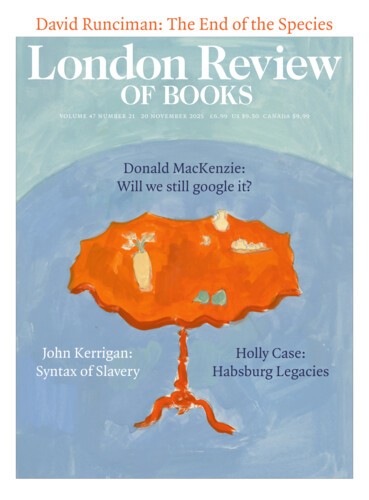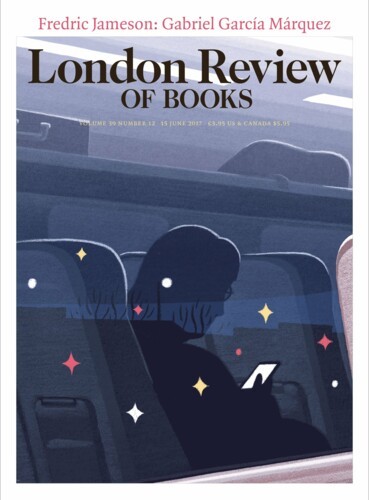One of the most striking images in Resistance, Steve McQueen’s survey of protest photography in 20th-century Britain (at Modern Two in Edinburgh until 4 January), is a blurry, black and white shot of Christabel Pankhurst, Flora Drummond and Emmeline Pankhurst in the dock at Bow Street Magistrates’ Court in 1908. The three suffragettes, on trial for incitement to disorder for a handbill that encouraged supporters to ‘rush’ the House of Commons, look towards the front of the courtroom with glazed expressions. They are leaning forward, elbows on the railings, heads propped up by hands. Are they listening intently or bored to death? Or are they feigning boredom in a display of contempt? The picture leaves the question hanging. The fact it exists at all is due to an act of subterfuge: it was taken by Arthur Barrett, a photographer for the Daily Mirror who smuggled a camera into court concealed in his top hat. He had cut a small flap in the hat to allow the lens to peek out and, as he said later, ‘clicked the shutter and coughed at the same time and hurried out of court’.
The exhibition covers the period between 1903 and 2003, beginning with the suffragettes and ending with images of protests in London and Edinburgh against the Iraq War. Although the events depicted are familiar territory for an exhibition concerned with social history – the Great Depression, postwar immigration, Greenham Common, the miners’ strike – McQueen foregrounds the photographic image itself as a site of political struggle. For the most part, he avoids bombastic or stylised imagery. (There are some works from the Picture Post tradition, but these are in the minority.) Instead, this selection of almost two hundred images, displayed as small or medium-sized black and white prints, draws attention to the camera’s ambiguous role in representing popular movements that sought to challenge power. The section on the suffragettes, for instance, displays pictures taken for a range of purposes. Some, like Barrett’s stolen snap, reflect the appetites of the news media, driven by commerce and sensation, but which campaigners learned to use to their advantage, tipping off press photographers about their plans in advance. (An image from 1910 of Ada Wright, sprawled on the floor outside the House of Commons after being assaulted by policemen, was considered so shocking that the government demanded the negatives be destroyed after the Mirror ran it on its front page.) Sometimes, members of the movement took contro of the camera, as Norah Smyth did when documenting the East London Federation of the Suffragettes; at other times, the camera was wielded for actively hostile purposes – as in a Special Branch surveillance image of the Pankhursts.
McQueen’s own images don’t feature in the exhibition, but the curation reflects his artistic as well as political concerns. The subject matter overlaps with his cinematic interest in British social history – the 2020 Small Axe anthology on West Indians in the UK, for instance, or last year’s Blitz – but there’s also an affinity between the way the power dynamics of the photographs shift throughout the exhibition and the unstable, intimate but also slightly voyeuristic way in which McQueen’s camera noses up to people and withdraws again in his own films. (Think of the ecstatic dance scene in ‘Lover’s Rock’ from Small Axe, or the close-ups of prisoners’ bodies in Hunger.) McQueen takes us very close – uncomfortably close – to his subjects, but in ways that never allow us to forget the presence of the camera. Illicit photographs crop up more than once in Resistance, but their context varies. With Special Branch and the suffragettes, it’s the state watching those it deems subversive. An undated surveillance photo, which appears in a section on fascism, was taken by postwar anti-fascists keeping tabs on the far right. They’re using similar methods to Special Branch, but to different ends.
It is striking how many people are smiling in the images on display. In a picture from 1949-50, taken by an unknown photographer, sharply dressed men and women beam at the camera. It could be a wedding or a birthday party (and perhaps it is) but the subjects are members of the anti-fascist 43 Group, a network of Jewish ex-servicemen and others who campaigned against the resurgent British far right after the Second World War. Their tactics weren’t pretty. They turned up at Oswald Mosley’s public meetings and started fights or rushed the platform. They tracked far-right activists and sometimes, on quiet, dark streets, beat them up. But the group portrait shows a different side to their activities, and an emotion that, in the context, is just as politically potent. It’s not a stretch to imagine that everyone in the photograph knew someone who had been murdered in the Holocaust. This kind of celebratory defiance recurs throughout the exhibition. Sometimes it’s deployed as a deliberate political tactic. Members of the Gay Liberation Front are pictured in drag in 1971 outside Bow Street Magistrates’ Court (that place again) after having disrupted the Miss World competition. At other times, as in Matthew Smith’s image of revellers with their arms in the air at a warehouse party in Bristol in 1995, the year after the Criminal Justice Act tried to shut down the rave scene, the defiance is spontaneous.
‘Resistance has been my life,’ McQueen writes in his introduction to the catalogue (Monument Books, £25). To explain what he means by that, he cites two encounters from his childhood: a neighbour who used to pass him newspaper cuttings with stories about revolutions and uprisings; and his experience of being sent to a Black supplementary school in the 1970s – his parents’ way of countering racist discrimination in mainstream education. To this, he adds the exhilaration he felt taking part in his first demonstration – against the abolition of student maintenance grants – in the late 1980s. McQueen is the product of a time when a particular view of progressive politics was in the ascendant, one that sees social change as the product of distinct grassroots movements, each centred on a particular cause. You can see this reflected in the arrangement of the exhibition. Although the overall structure is chronological, images are grouped together by theme – workers’ rights, feminism, anti-racism and so on. These diverse struggles, the curation implies, contribute cumulatively to the fight against injustice.
That might seem an obvious point, since it’s our standard way of thinking about left-wing politics. But it’s a choice nonetheless, and it raises a question about the period covered by the exhibition. Resistance spans the hundred years or so during which the photographic print was the primary medium of visual communication. Aesthetically and technically, this makes sense. Politically, however, it’s curious, since many of the causes represented in the exhibition are under assault again today, both in the UK and abroad. By looking back, without any explicit connection to the present, doesn’t Resistance run the risk of becoming an exercise in nostalgia? Or does it have something to tell us about our own time?
That question is harder to answer than McQueen might wish. Sweeping narratives have trade-offs. We don’t learn much about the way the subjects of the photographs understood their struggles or the way this might have changed over time. The communists and socialists pictured in the hunger marches of the 1920s and 1930s would have stressed the importance of organising, on the basis of class, in an international movement. How had that changed by the time of the miners’ strike? Nor is there much interrogation of the concept of resistance itself. The inclusion of pictures of National Front members in the 1970s (who presumably thought they were resisting something) shows that resistance is not always a progressive force. And what about the missteps and conflicts that arise among those who share a common cause? As Daniel Sonabend recounts in his history of the 43 Group, We Fight Fascists (2019), the network included both Zionist and anti-Zionist Jews; they could agree on the need to fight fascism, but not on the need for a Jewish state or the methods that should be employed to establish it. Other disagreements and contradictions are present but not acknowledged. Emmeline Pankhurst, at one point in her life, thought British imperialism was good for the world; Jomo Kenyatta, posing for a portrait at the Fifth Pan-African Congress in Manchester in 1945, plainly did not. No exhibition can be exhaustive, but a few provocations would make for a more interesting, and more useful, show.
Resistance mitigates its constraints thanks in part to a fluid layout. The different thematic sections are not rigidly demarcated; in some rooms two or more themes jostle for space and some pictures are placed out of chronological order. This gives the feeling of dozens of little time loops and hops – the suffragettes’ propaganda-of-the-deed tactics blur into the ‘die-ins’ staged by hunger marchers in Central London several decades later; the South Asian women leading the Grunwick strike of 1977 are jumbled up with white miners on strike at Easington in 1984. A room devoted to anti-fascist and anti-racist struggles leads onto a corridor in which a few haunting pictures from the Troubles are displayed, including two taken with a camera smuggled into a prison.
These hazy boundaries serve to refocus our attention on what’s distinctive in these photographs, and especially on those that show people simply getting on with the business of living. Paul Trevor’s photographs of Bangladeshis in Brick Lane in the 1970s capture a community resisting racist discrimination and violent intimidation from the National Front. Many Bangladeshis were unfairly denied council housing, to which the community responded with one of the UK’s most successful mass squatters’ movements. Trevor’s images of street demonstrations have found their way into other recent exhibitions, such as The 1980s: Photographing Britain at Tate Britain earlier this year. But here they are accompanied by pictures of the community’s domestic life. The homes they show are dilapidated, crowded, plainly insufficient. But that’s not all they show. In one image, a woman in a sari delivers a lesson to a dozen small children, caught with their mouths open, mid-recital. This tells us as much, if not more, about what ‘resistance’ can look like.
It’s unguarded moments like these that make the familiar strange again. Hunger-march organisers oversee camp breakfasts, while fifty years later volunteers prepare meals in a solidarity kitchen at Easington during the miners’ strike. Mourners fill the streets for the funeral of Kelso Cochrane, murdered by racists in Notting Hill in 1959. The Headscarf Revolutionaries – women from Hull who campaigned for greater safety at sea after the deaths of trawlermen in the 1960s – quietly read through their notes on the train to London, en route to Parliament. ‘We are here, we are alive and we matter,’ is the message so many of these images convey. But, much like McQueen’s other explorations of British history, Resistance leaves it to us to work out what that legacy means today.
Send Letters To:
The Editor
London Review of Books,
28 Little Russell Street
London, WC1A 2HN
letters@lrb.co.uk
Please include name, address, and a telephone number.



